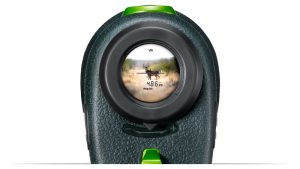My first rangefinder had nearly the same dimensions as a Cracker Jack box. Dangling the rectangular-shaped box around my neck wasn’t really an option, so it was shoved awkwardly into the pocket of my pants. The device was about as much fun to tote around the woods as a case of hemorrhoids.
Optical clarity was terrible. Out to 30 yards, the rangefinder was somewhat accurate. Beyond that, unless the object ranged was the size of a dump truck, an accurate reading was impossible.
My how times have changed. Today’s rangefinders aren’t even the length of a human hand. They’re lightweight and extremely ergonomic. They boast excellent optical clarity, feature angle-compensation technology and typically measure distances to the nearest tenth of a yard.
Anyone that followed my “Life Of A Bowhunter 2016” blog knows I’m a big fan of SIG’s KILO 2000. I used the rangefinder exclusively from August through November. The rangefinder provided instant yardage readings, was crystal clear and ergonomic, and never let me down in the field. For these reasons, I was a little hesitant to switch things up for my last bowhunt of the year.
Nikon’s ARROW ID 7000 VR
Sure, I’d read all about Nikon’s ARROW ID 7000 VR. I knew it was being heralded as the world’s first laser rangefinder to feature optical vibration reduction. That it featured what Nikon is calling a “bright, 6X monocular.” That it provided accurate distance readings from 8 to 1,000 yards.
And, of course, the 7000 features Nikon’s ID (Incline/Decline) Technology: a technology that provides horizontal distance to the target, even when ranging objects at +/- 89 degrees. Yes, that’s nearly vertical up or down. What I hadn’t done was put the rangefinder to the test in the woods and let the success of my hunt hinge on it.
So to be brutally honest, all the aforementioned bells and whistles meant very little to me.
Easy Set-Up
I like rangefinders that boast easy set-up and it doesn’t get much easier than the ID 7000 VR. In fact, the rangefinder came set up and ready to bowhunt. All I had to do was unscrew the round knob on the bottom and insert the battery. The factory settings had the rangefinder set to read in yards, First Target Priority mode was enabled and the Horizontal Distance mode was activated.I was ready for the woods but, for the sake of testing, I toggled through the other settings.
All About Buttons
Changing the unit of distance from yards to meters required a long press of the mode button (hold the button until you see F1 displayed in the viewfinder). A short press of the power button prompts the unit to change from yards to meters. Switching from Horizontal Distance mode to Actual Distance mode requires a long press of the mode button followed by a short press of the mode button.
You’ll know you got it right if you see an F2 display in the viewfinder. A short press of the power button changes the unit from Horizontal to Actual. Lastly, a long press of the mode button followed by a pair of short mode button presses will display the F3 screen. A short press of the power button will with shift the unit from First Target Priority mode to Distant Target Priority mode.
A simple push of the power/range button will bring up crosshairs, and a second push provides instant target distance read-back. If you hold down the range button, you can swing the rangefinder to other targets and it will keep a running distance.
 How It Performs
How It Performs
The rangefinder comes with a Realtree-cloaked camo case that keeps it protected and warm. It isn’t bulky enough to hurt overall functionality. In the past, I struggled with protective covers. They tend to slide and often make hitting the necessary buttons difficult. This wasn’t the case with the 7000 VR’s case.
I appreciated the large eyepiece and the highly touted Vibration Reduction Technology. Temperatures on our northern Texas hunt hovered in the low teens and a crisp wind cut through the open plains. Shaking was inevitable, but I had zero trouble ranging deer in the open landscape. Even when shivering I was able to get a somewhat stable view and grab a quick range. The enhanced size of the monocular allowed for rapid target acquisition. Optical focus was easily achieved by simply turning they eyepiece toward the + or - signs clearly labeled on the rangefinder body.
The crosshairs and yardage readout — even in low light — were crystal clear in the viewfinder. As far as the 6X optics, I really appreciated the magnification when ranging deer in the vast expanses of broken country. It was also evident that Nikon’s shiny new penny boasted a bit of eye relief. Because we were hunting in open terrain littered with tall grass, sage and plum thickets, I opted to set my rangefinder to the Distant Target Priority mode. When using this mode, the 7000 ignored pieces of grass and brush that obstructed the target, giving the readout of my target animal. When spotting and stalking, this mode is a godsend. During the evening when sitting in a ground blind, I switched back to the First Target Priority mode.
I could hear a small click each time I pressed the power button, but the sound wasn’t enough for a big game animal to distinguish.
The Bottom Line
I give this “smart” rangefinder two thumbs up and would recommend it to anyone looking to make a new yardage-detector purchase.
Specs
Measurement Range: 8 to 1,000 yards
Increment Reading: .1 yards
Magnification: 6X
Viewfinder Display: Meters/Yards
Eye Relief: 18 mm
Power Source: 1 CR2 Lithium Battery
Size: 3.9x1.9x3.0
Weight: 7 ounces
Objective Diameter: 21mm
Waterproof: Yes






